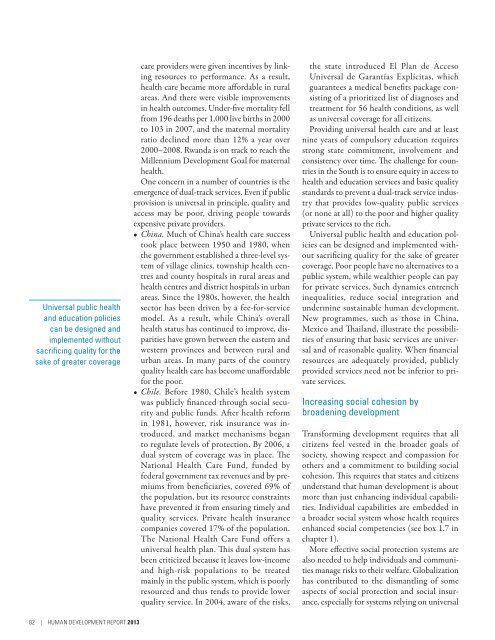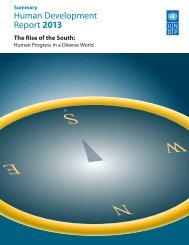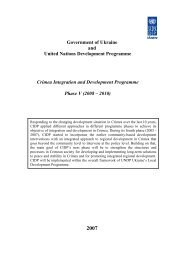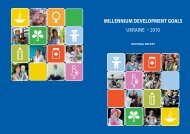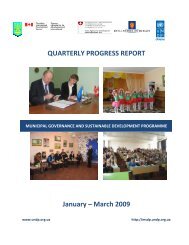E N S W - United Nations Development Programme
E N S W - United Nations Development Programme
E N S W - United Nations Development Programme
You also want an ePaper? Increase the reach of your titles
YUMPU automatically turns print PDFs into web optimized ePapers that Google loves.
Universal public health<br />
and education policies<br />
can be designed and<br />
implemented without<br />
sacrificing quality for the<br />
sake of greater coverage<br />
care providers were given incentives by linking<br />
resources to performance. As a result,<br />
health care became more affordable in rural<br />
areas. And there were visible improvements<br />
in health outcomes. Under-five mortality fell<br />
from 196 deaths per 1,000 live births in 2000<br />
to 103 in 2007, and the maternal mortality<br />
ratio declined more than 12% a year over<br />
2000–2008. Rwanda is on track to reach the<br />
Millennium <strong>Development</strong> Goal for maternal<br />
health.<br />
One concern in a number of countries is the<br />
emergence of dual-track services. Even if public<br />
provision is universal in principle, quality and<br />
access may be poor, driving people towards<br />
expensive private providers.<br />
• China. Much of China’s health care success<br />
took place between 1950 and 1980, when<br />
the government established a three-level system<br />
of village clinics, township health centres<br />
and county hospitals in rural areas and<br />
health centres and district hospitals in urban<br />
areas. Since the 1980s, however, the health<br />
sector has been driven by a fee-for-service<br />
model. As a result, while China’s overall<br />
health status has continued to improve, disparities<br />
have grown between the eastern and<br />
western provinces and between rural and<br />
urban areas. In many parts of the country<br />
quality health care has become unaffordable<br />
for the poor.<br />
• Chile. Before 1980, Chile’s health system<br />
was publicly financed through social security<br />
and public funds. After health reform<br />
in 1981, however, risk insurance was introduced,<br />
and market mechanisms began<br />
to regulate levels of protection. By 2006, a<br />
dual system of coverage was in place. The<br />
National Health Care Fund, funded by<br />
federal government tax revenues and by premiums<br />
from beneficiaries, covered 69% of<br />
the population, but its resource constraints<br />
have prevented it from ensuring timely and<br />
quality services. Private health insurance<br />
companies covered 17% of the population.<br />
The National Health Care Fund offers a<br />
universal health plan. This dual system has<br />
been criticized because it leaves low-income<br />
and high-risk populations to be treated<br />
mainly in the public system, which is poorly<br />
resourced and thus tends to provide lower<br />
quality service. In 2004, aware of the risks,<br />
the state introduced El Plan de Acceso<br />
Universal de Garantías Explícitas, which<br />
guarantees a medical benefits package consisting<br />
of a prioritized list of diagnoses and<br />
treatment for 56 health conditions, as well<br />
as universal coverage for all citizens.<br />
Providing universal health care and at least<br />
nine years of compulsory education requires<br />
strong state commitment, involvement and<br />
consistency over time. The challenge for countries<br />
in the South is to ensure equity in access to<br />
health and education services and basic quality<br />
standards to prevent a dual-track service industry<br />
that provides low-quality public services<br />
(or none at all) to the poor and higher quality<br />
private services to the rich.<br />
Universal public health and education policies<br />
can be designed and implemented without<br />
sacrificing quality for the sake of greater<br />
coverage. Poor people have no alternatives to a<br />
public system, while wealthier people can pay<br />
for private services. Such dynamics entrench<br />
inequalities, reduce social integration and<br />
undermine sustainable human development.<br />
New programmes, such as those in China,<br />
Mexico and Thailand, illustrate the possibilities<br />
of ensuring that basic services are universal<br />
and of reasonable quality. When financial<br />
resources are adequately provided, publicly<br />
provided services need not be inferior to private<br />
services.<br />
Increasing social cohesion by<br />
broadening development<br />
Transforming development requires that all<br />
citizens feel vested in the broader goals of<br />
society, showing respect and compassion for<br />
others and a commitment to building social<br />
cohesion. This requires that states and citizens<br />
understand that human development is about<br />
more than just enhancing individual capabilities.<br />
Individual capabilities are embedded in<br />
a broader social system whose health requires<br />
enhanced social competencies (see box 1.7 in<br />
chapter 1).<br />
More effective social protection systems are<br />
also needed to help individuals and communities<br />
manage risks to their welfare. Globalization<br />
has contributed to the dismantling of some<br />
aspects of social protection and social insurance,<br />
especially for systems relying on universal<br />
82 | HUMAN DevELOPMENT REPORT 2013


